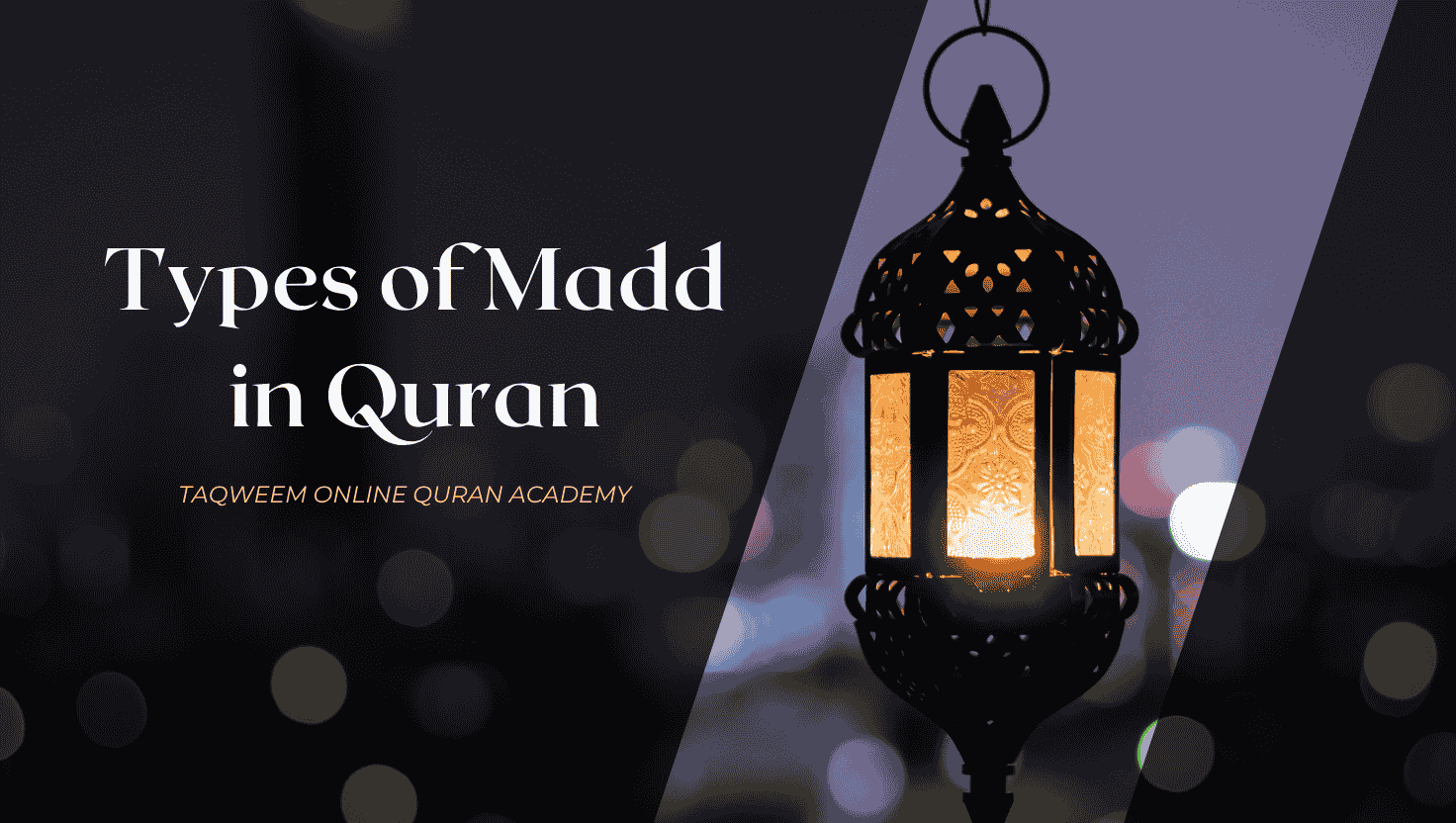When reciting the Quran, we often draw out the sound for a certain length — this is called “Madd.”
Madd means “to lengthen” or “to increase the sound.” This is one of the most important principles of Tajweed, because performing Madd correctly maintains both beauty, melody, and meaning in the recitation of the Quran.
Table of Contents
ToggleWhat is Madd?
Madd comes from the Arabic word “madd”, which means “to lengthen.”
When a letter is followed by a hamza (ء) or a sukoon ( ْ ), it is necessary to draw out the sound for some time during recitation.
Example:
قَالَا – Here there is a Madd on “ا”, and the reader reads it a little longer.
Understanding the types of Madd is very important for the correct recitation of the Holy Quran.
Main Types of Madd in Quran
According to experts in the science of Tajweed, there are two main types of Madd:
-
Madd Asli (Natural Madd)
-
Madd Far‘i (Secondary Madd)
Let’s understand both of them in detail.
1. Madd Asli (Mad Asli)
Madd Asli is also called Madd Tabee‘i, i.e. natural Madd.
This is the Madd that is present without any specific reason (hamza or sukun).
Definition:
When a Madd letter (ا, و, ي) is preceded by a zabr, presh, or zirr, and no hamza or sukun comes after it, then it is called Madd Asli.
Examples:
-
Qaala (قَالَا)
-
Qeela (قِيلَ)
-
Yaqoolu (يَقُولُ)
Length:
It is stretched to two movements (i.e. the time equal to one little finger).
2. Madd Far‘i (Mad Far‘i)
Madd Far‘i is produced when the sound of the Madd is increased by an additional factor (hamza or rest).
It is longer than the original Madd.
Types of Madd Far‘i:
1. Madd Munfasil (Mad Separated)
When the letter Madd is at the end of a word and the hamza (ء) is at the beginning of the next word.
Example: فِي آمَنُوا
Stretch: Four or five movements
2. Madd Muttasil (Mad Connected)
When the letter Madd and the hamza (ء) are in the same word.
Example: جَاءَ – سَاءَ
Stretching: Four to five movements
3. Madd Laazim (Mad Laazim)
When a silent letter comes after the letter Madd, whether in a word or in a letter.
Types:
-
Madd Laazim Kalimi (Lafzi)
-
Madd Laazim Harfi (Lafzi)
Example: الضَّالِّينَ – الم
Stretching: Up to six movements
4. Madd Aarid Lis-Sukoon (Mad Aarid Lis-Sukoon)
When a silent letter appears at the end of a word during recitation.
Example: العَالَمِينْ
Stretching: Two, four, or six movements
5. Madd Lin (Mad Lin)
When a stressed letter comes before a vowel or a silent letter.
Example: خَوْف – بَيْت
Stretching: Two, four, or six movements

Summary Chart
| Type | Reason | Example | Movements |
|---|---|---|---|
| Madd Asli | No specific reason | قَالَ | 2 |
| Madd Munfasil | Hamza in the next word | فِي آمَنُوا | 4–5 |
| Madd Muttasil | Hamza in the same word | جَاءَ | 4–5 |
| Madd Laazim | Calmness is mandatory | الضَّالِّينَ | 6 |
| Madd Aarid | Calmness is achieved by stopping | العَالَمِينْ | 2–6 |
| Madd Lin | Zabar before واو/يا | خَوْف | 2–6 |
Importance of Correct Pronunciation of Madd
The Holy Quran was revealed in Arabic, and the nuances of pronunciation in Arabic can change the meaning.
If Madd is stretched more or less, the meaning can change.
Example:
-
مَلِك (King)
-
مَالِك (Owner)
These two have different meanings, and a slight change in the Madd can change the meaning.
That is why reciting the Quran with the correct Madd is not only part of Tajweed but also a requirement of respect for the Quran.
Also Read : Common Mistakes in Reading the Quran and Their Solutions
Best Ways to Learn Madd
If you want to recite the Quran with Tajweed, it is essential to practice Madd daily.
Here are some practical ways:
-
Watch Tajweed videos (YouTube, Taqweem Online Quran Academy Tutorials)
-
Listen to Quran reciters — such as Qari Abdul Basit, Mishary Rashid, Al-Minshawi
-
Practice with Tajweed books and PDF notes
Taqweem Online Quran Academy — The Best Way to Learn Quran Tajweed
If you want to learn to recite the Quran with the correct Tajweed and Madd principles,
then Taqweem Online Quran Academy is the best choice for you.
At Taqweem Academy:
-
Experienced Arab and Pakistani teachers
-
One-on-One classes
-
Separate courses for children, women, and adults
-
Live classes on Zoom / Skype
-
Free trial class opportunity 🎓
👉 Register now and Get 3 days Free Trial now
Spiritual Benefits of Learning Madd
Reciting the Quran with correct pronunciation is not just a linguistic skill but also a spiritual act of worship.
When a reciter recites the Quran with Tajweed and Madd, peace, humility, and faith arise in the heart.
The Prophet (peace and blessings of Allah be upon him) said:
“Whoever does not recite the Quran with a beautiful voice is not one of us.”
(Sahih Bukhari)
That is, creating beauty and gentleness in the recitation of the Quran is the true Sunnah.
Closing Message
Learning the principles of Madd is essential for every Muslim reciter.
It not only beautifies the recitation but also serves as a means of correct delivery of the word of Allah.
If you want to learn the Quran with Tajweed,
then contact Taqweem Online Quran Academy today —
where you are taught the Quran with experienced teachers, a structured curriculum, and a spiritual environment.
Taqweem Online Quran Academy — Learn Quran the Right Way, with Love & Tajweed.
FAQs:
What are the different types of Madd charts?
Madd charts in Tajweed visually explain the types of elongation (Madd) and their lengths. They include Madd Asli (Natural Madd) and Madd Far’ee (Secondary Madd), each with specific rules and examples from the Quran.
What is the difference between Madd Muttasil and Madd Munfasil?
Madd Muttasil occurs when a Madd letter is followed by a Hamzah in the same word, while Madd Munfasil happens when the Madd letter is in one word and the Hamzah in the next. Madd Muttasil is generally read longer.
How many types of Madd under Madd Far’ee?
There are eight types of Madd Far’ee, including Madd Muttasil, Madd Munfasil, Madd Lazim, Madd Aridh Lis-Sukoon, Madd Lin, Madd Badal, Madd Silah Qasirah, and Madd Silah Tawilah.
How many letters are in Madd?
There are three Madd letters in Tajweed: Alif (ا), Waw (و), and Ya (ي). These are the letters of elongation used to stretch the sound in recitation.
How many types of Madd are in Tajweed?
There are two main types of Madd in Tajweed:
-
Madd Asli (Natural Madd) — the basic elongation of two counts.
-
Madd Far’ee (Secondary Madd) — extended elongation based on Hamzah or Sukoon, ranging from four to six counts.
What is Ghunnah?
Ghunnah is a nasal sound that comes from the nose, lasting two counts. It occurs during the pronunciation of Meem (م) and Noon (ن) when they are doubled or have a Shaddah (ّ).
What is Sukun?
Sukun ( ْ ) is a diacritical mark placed above a letter to show that it should be pronounced without a vowel sound. It plays an essential role in the rules of Idgham, Ikhfa, and Qalqalah in Tajweed.
What is Hamzatul Wasl?
Hamzatul Wasl (ٱ) is a connecting Hamzah that is pronounced only when starting a word but dropped when continuing from the previous word. It helps smooth recitation in continuous reading.






